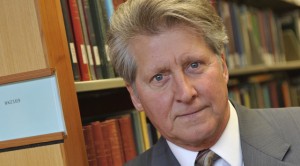In the past year and a half, three of our most prominent Catholic literary critics – Dana Gioia, Gregory Wolfe, and Paul Elie – have been engaged in a debate about the state of Catholic literature in the English-speaking world. Though this debate is of special interest to Catholics with a love of literature and the arts, the stakes involved should interest every Catholic: for what is at issue is nothing less than whether and how Catholics are going to have a voice in one of the most important sectors of culture.
Dana Gioia, former Chairman of the National Endowment for the Arts, currently a professor at the University of Southern California, and, not least, a poet of international renown, kicked off the debate in December 2013 with an article in First Things, “The Catholic Writer Today.” In this lengthy and penetrating piece, Gioia argues that Catholic literature is in decline. He compares the condition of American Catholic literature in the mid 20th century – “the first full flowering of the American Catholic imagination” – to its condition today and finds the difference “shocking.”
In the two decades following the end of the Second World War, “Catholic voices in all their diversity played an active role in shaping the dynamic public conversation that is American literature. Catholicism was not only seen as a worldview consistent with a literary or artistic vocation. Rich in rituals, signs, and symbols, the Roman church was often regarded as the faith most compatible with the artistic temperament.”
Not so today. As Gioia surveys the present landscape, he sees that fewer important writers publicly identify themselves as Catholic, the influence of the Catholic literary tradition on the culture has waned, and that the cultural establishment, in turn, is all too happy to snub the faith, an attitude typified by Booker Prize-winning novelist Hilary Mantel’s snarky declaration that “Nowadays the Catholic Church is not an institution for respectable people.”
Paul Elie, author of The Life You Save May Be Your Own, a four-way biography of Flannery O’Connor, Walker Percy, Dorothy Day, and Thomas Merton, agrees with Gioia: “If any patch of our culture can be said to be post-Christian, it’s literature.”
So we Catholics beat on, boats against the current, borne back ceaselessly into the past with Chesterton, Belloc, Greene, Waugh, Powers, Percy, and O’Connor. . .
That kind of nostalgia is one kind of response to the narrative of decline, one that is often expressed in discussions about the state of Catholic literature, but it isn’t the response Gioia advocates. Gioia urges Catholic writers to get back into the game, to recapture a sense of shared mission, and to “renovate and reoccupy our own tradition.”

There is yet another response to the narrative of decline: that the narrative is a fiction. Gregory Wolfe, founder and editor-in-chief of Image, a journal of faith and the arts, has pushed back against the idea that Catholic influence has waned in English-speaking letters, as witnessed by the acclaimed work of more recent Catholic writers such as Ron Hansen, Alice McDermott, Cormac McCarthy, Oscar Hijuelos, Andre Dubus, and many others. For Wolfe, Catholic writers never left the game; they’ve been on the field playing, and rather well, all along.
So why haven’t we added the names of Hansen, McDermott, et alia to our pantheon of great Catholic writers? Many do add them, of course, but for many others their names do not resonate in the same way as those of Chesterton, Greene, and Waugh. A good part of the reason for this, Wolfe claims, is that the more recent Catholic writers “have been far more inclined to whisper.”
The reference is to Flannery O’Connor’s famous statement of her own aesthetic: “The novelist with Christian concerns will find in modern life distortions which are repugnant to him, and his problem will be to make these appear as distortions to an audience which is used to seeing them as natural. . . .to the hard of hearing you shout, and to the almost blind you draw large and startling figures.”
Wolfe sees recent Catholic writers who grapple with faith as less engaged than the previous generation with the struggle against 20th-century secular attacks on religion. These writers are “less sure they can, or should, create these big silhouettes. They’re more interested in the scrimshaw of private life.” They are whisperers rather than shouters. And the problem, according to Wolfe, is that we’re not listening to them.
This dichotomy between shouts and whispers, however, is somewhat misleading. Certainly O’Connor and others did make use of the big silhouette and the grand gesture. Think of the horrifying conclusion of O’Connor’s short story, “A Good Man Is Hard to Find,” or the dramatic deathbed conversion in Waugh’s Brideshead Revisited. But these writers were also capable of treating struggles with faith as well as other subjects in more muted tones and in more intimate settings, as we find in O’Connor’s short story, “The Enduring Chill,” and Waugh’s domestic tragedy, A Handful of Dust.
The dichotomy of shouts and whispers has not so much to do with tone and setting as with a posture toward post-modernity. “We live in a secular world,” attests Wolfe, “where any grand narrative is suspect, where institutions are seen as oppressive.” So the shaky metaphysical backdrop of Catholicism and its despised institutions have driven many Catholic writers indoors, where they depict faith as it is struggled with in the privacies of the human heart.
And there is the root cause of the lingering sense of decline that many Catholics feel about the state of Catholic literature: it is the fact that recent Catholic writers have abjured the public face, the social and political nature, of Catholicism; they have failed to speak of the problem of how to live the faith in a world that finds that public face disrespectable.
Whether in shouts or whispers, that is the voice we long to hear.














